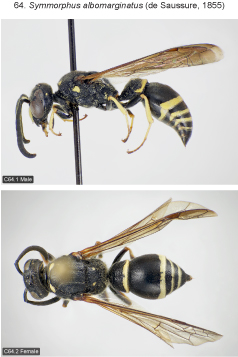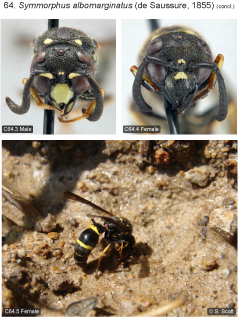
| Home | Table of contents | Keys | Species list | Glossary | Image data | PDF | Cite this article | Feedback | Updates |
Identification Atlas of the Vespidae (Hymenoptera, Aculeata) of the northeastern Nearctic region
CJAI 05, February 19, 2008
doi: 10.3752/cjai.2008.05
Matthias Buck, Stephen A. Marshall, and David K.B. Cheung
Department of Environmental Biology, University of Guelph, Guelph, Ontario, Canada N1G 2W1
Next species | Previous species | Key
64. Symmorphus albomarginatus (de Saussure, 1855)
Figs B2.11, 13, 35; B8.1, 3, 8; C64.1–5.

|

|
Species recognition. Symmorphus albomarginatus is similar to S. cristatus, from which it can be separated by the characters given in the key. The following characters are also helpful: size larger than the other two species in the genus; flagellomere XI of male black except for tyloid (more extensively reddish in other species); hairs of ventral surface of hind femur as in S. cristatus, longer than in S. canadensis; tergum 3 almost always with apical fascia in northeastern specimens (usually absent in S. cristatus), but often absent in specimens from eastern U.S. (Cumming 1989).
Variation. Fore wing length 7–7.5 mm (♂♂), 8.5–9.5 mm (♀♀). Pale markings usually ivory in Canadian populations except most specimens from Carolinian life zone, yellow in specimens from Pennsylvania and southern New York southward (Cumming 1989). Female clypeus with basal pale spot narrow to wide, rarely absent. Interantennal spot rarely absent. Scape with anteroventral surface black or pale-marked in female, pale mark always present in male, usually extending more than halfway to apex. Pronotum with a pair of pale spots of variable size, very small in some males. Pale spot on mesopleuron and pair of spots on scutellum sometimes absent in male. Tegula black or brown marked with pale or completely black. Female tibiae with pale markings usually restricted to outer surface, rarely almost absent. Metasoma with apical fasciae developed on terga 1–4 and sometimes 5 (rarely in female), exceptionally absent on tergum 3 (see above). Sterna 2–5 with posterolateral pale spots or more or less complete fascia; the fascia usually narrowly interrupted on sternum 2, reduced to small spots on following sterna.
Distribution. Transcontinental in Canada (not recorded from NU) and U.S., absent from desert areas of southwestern U.S. and southern Great Plains. The ssp. midas Cumming, 1989 ranges from southeastern TX through Mexico to northern Nicaragua (Cumming 1989).
Biology. Nests in borings in wood, sumac and elderberry stems, and uses mud for cell partitions and closing plugs. Prey are Chrysomela larvae (Krombein 1967, 1979).
Next species | Previous species | Key
| Home | Table of contents | Keys | Species list | Glossary | Image data | PDF | Cite this article | Feedback | Updates |
